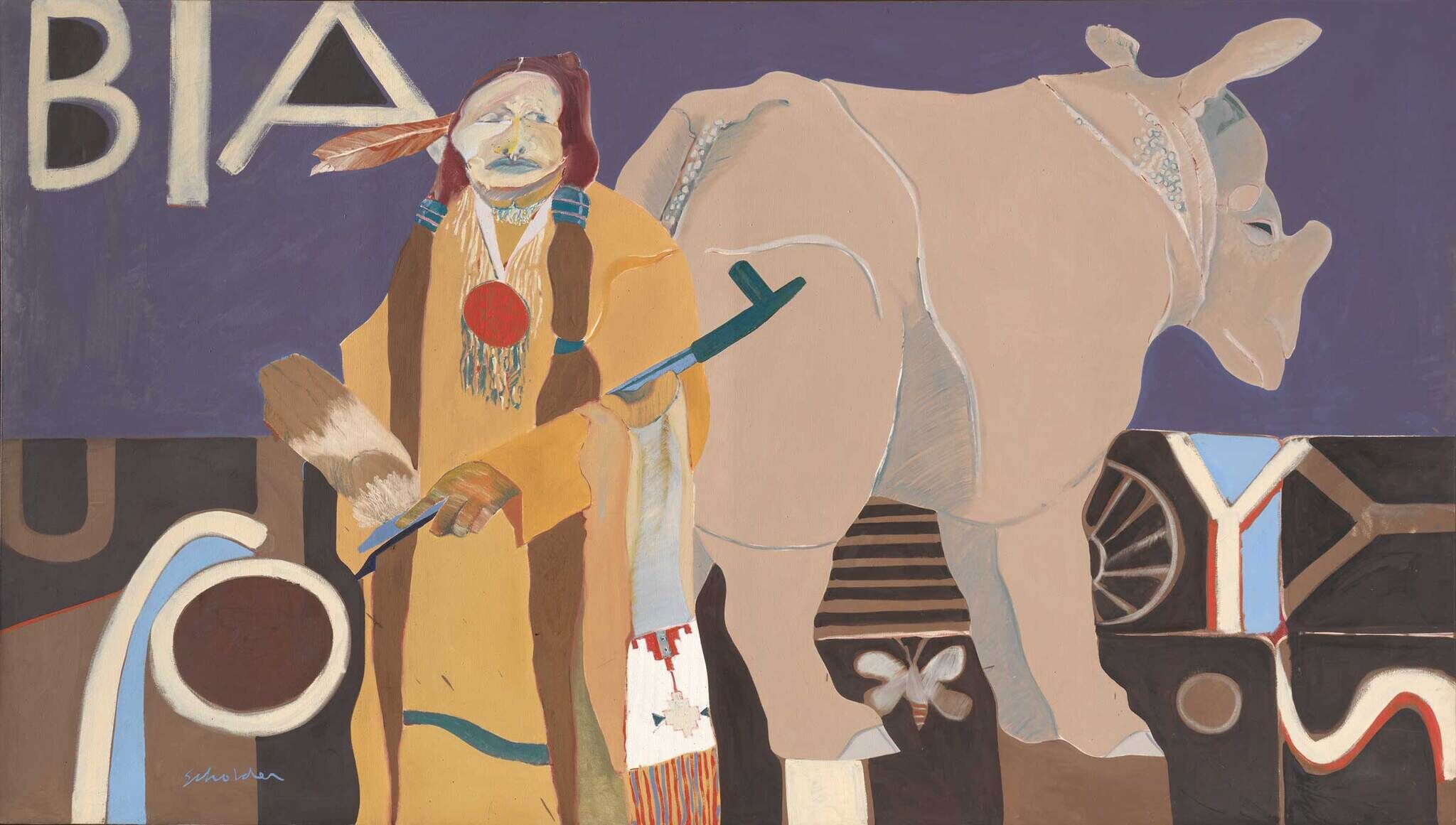Sixties Surreal | Art & Artists
Show of Force
6
In the 1960s television brought reports of political assassinations, the oppression of protests, and the escalation of the Vietnam War (1955–75) into the comfort of American living rooms. The works in this gallery illustrate the many ways in which the violence and oppression of the era were experienced, internalized, and expressed through art. Some artists drew on the visual and literary vocabulary of historic Surrealism, a movement that embraced and extolled revolutionary actions, to communicate the experience of racial or colonial oppression. Other artists manipulated the very material of mass media to excoriate the culture it portrayed—framing violence as a kind of rupture in the fabric of logic.
Fritz Scholder, Indian and Rhinoceros, 1968
"My painting called Indian and Rhinoceros has an Indian in full dress with a peace pipe posing with an ungainly rhinoceros in front of the Bureau of Indian Affairs [BIA]. My point, I believe, is obvious." An enrolled member of the Luiseño tribe, Fritz Scholder's statement underscores the cruel absurdity of the US government's relationship with Native Americans. The BIA, an agency within the Department of the Interior, was responsible for enforcing decades of federal policies designed to terminate tribal authority and relocate and assimilate Indigenous people. Galvanized by the escalation of the Vietnam War, in which Native American men disproportionately served, and the 1968 founding of the American Indian Movement (AIM), an activist group focused on Native American civil rights, Scholder felt compelled to address the violence of American history and the mistreatment of Indigenous people for the first time in his work.
Artists
- Jeremy Anderson
- Benny Andrews
- Kenneth Anger
- Diane Arbus
- Robert Arneson
- Ralph Arnold
- Romare Bearden
- Jordan Belson
- Ed Bereal
- Wallace Berman
- Judith Bernstein
- Lee Bontecou
- Louise Bourgeois
- Joan Brown
- Kay Brown
- Roger Brown
- T.C. Cannon
- Eduardo Carrillo
- Mel Casas
- Vija Celmins
- Barbara Chase-Riboud
- Ching Ho Cheng
- Judy Chicago
- Bruce Conner
- Jean Conner
- Adger Cowans
- Robert Crumb
- Dale Brockman Davis
- Jay DeFeo
- Roy De Forest
- Martha Edelheit
- Melvin Edwards
- Ed Emshwiller
- Roy Fridge
- Lee Friedlander
- Rupert Garcia
- Nancy Graves
- Nancy Grossman
- Barbara Hammer
- David Hammons
- Alex Hay
- Wally Hedrick
- Mike Henderson
- Eva Hesse
- Oscar Howe
- Luchita Hurtado
- Miyoko Ito
- Suzanne Jackson
- Ken Jacobs
- Jae Jarrell
- Jess
- Luis Jimenez
- Daniel LaRue Johnson
- Barbara Jones-Hogu
- Edward Kienholz
- Kiki Kogelnik
- Shigeko Kubota
- Yayoi Kusama
- Lynn Hershman Leeson
- Linda Lomahaftewa
- Lee Lozano
- Marisol
- David McManaway
- Ron Miyashiro
- Bruce Nauman
- Gunvor Nelson
- Senga Nengudi
- Jim Nutt
- Claes Oldenburg
- John Outterbridge
- Edward Owens
- Kenneth Price
- Noah Purifoy
- Joseph Raffael
- Christina Ramberg
- Deborah Remington
- Faith Ringgold
- Suellen Rocca
- James Rosenquist
- Martha Rosler
- Barbara Rossi
- Edward Ruscha
- Betye Saar
- Niki de Saint Phalle
- Lucas Samaras
- Peter Saul
- Raymond Saunders
- Carolee Schneemann
- Fritz Scholder
- Kay Sekimachi
- Joan Semmel
- Jack Smith
- Ming Smith
- Robert Smithson
- Nancy Spero
- Anita Steckel
- Harold Stevenson
- Sturtevant
- Paul Thek
- Michael Cullen Todd
- Carlos Villa
- Shawn Walker
- Timothy Washington
- H.C. Westermann
- Jack Whitten
- Dorothy Wiley
- William T. Wiley
- Hannah Wilke
- Franklin Williams
- Karl Wirsum

